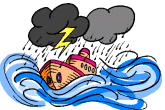

Hurricanes
 Frontal depressions in the mid-latitudes are often poorly defined features. Their tropical counterparts, in contrast, have very distinct shapes and can be easily identified on images provided by satellites. Tropical storms have different names in different parts of the world. Known as cyclones in the Indian Ocean, and typhoons in Southeast Asia, Hurricanes (the name used in the Caribbean) can be some of the most damaging weather phenomena on Earth.
Frontal depressions in the mid-latitudes are often poorly defined features. Their tropical counterparts, in contrast, have very distinct shapes and can be easily identified on images provided by satellites. Tropical storms have different names in different parts of the world. Known as cyclones in the Indian Ocean, and typhoons in Southeast Asia, Hurricanes (the name used in the Caribbean) can be some of the most damaging weather phenomena on Earth.
The word hurricane originates from West Indian language, meaning "big wind." The Caribbean and Gulf of Mexico experience the most organised annual season of hurricanes from about August through to October. These hurricanes begin life as disorganised storms which form over warm, tropical waters in the Atlantic. Usually surface seawater must be at least 27°C for there to be sufficient heat and moisture input into the atmosphere to generate the more violent storms. When wind speeds reach 75 mph (120 kph), the storm is classified as a hurricane.
On a synoptic chart, a hurricane appears as a set of almost circular, tightly packed isobars. Hurricanes are usually about 300 to 400 miles wide. The winds of a hurricane are structured around a central "eye", which is an area that is often free of clouds and relatively calm. Inside the eye of the hurricane, atmospheric pressure is very low, sometimes falling below 900 millibars. Around this "eye" area, storm clouds wrap in an anticlockwise manner (in the Northern Hemisphere) following the wind direction. This "eyewall" of clouds, wind and rain, is the most destructive part of the storm. In fact, it is the eyewall that creates the eye, since the rapid spinning clouds in the wall reduce the pressure in the eye and suck out any clouds that are present there.
 | Hurricane from space |
Websites
Other topics
• NOAA Hurricanes
• US Hurricane Center
• WW2010
• USA Today
• Franklin Institute
• Introduction to Weather
• Anticyclones
• Beaufort Scale
• Cirrus Clouds
• Clouds
• Cold Fronts
• Condensation
• Convection
• Cooling Air
• Cumulonimbus Clouds
• Cumulus Clouds
• Depressions
• Dew
• Dew Point
• Energy
• Evaporation
• Fog
• Forecasting
• Fronts
• Frost
• Humidity
• Hurricanes
• Isobars
• Measuring Weather
• Meteorology
• Monsoons
• Movement of Air
• Occluded Fronts
• Precipitation
• Pressure
• Sea Breeze
• Stability of Air
• Stratus Clouds
• Sunshine
• Synoptic Charts
• Temperature
• Thunderstorms
• Tornadoes
• Uplift of Air
• Warm Fronts
• Water Cycle
• Weather Symbols
• Wind
 Print Topic
Print Topic